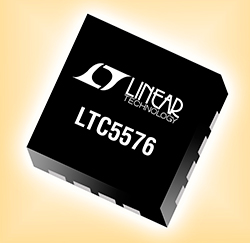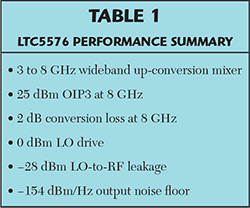
Linear Technology’s 3 to 8 GHz wideband mixer is optimized for up-conversion applications. The LTC5576 comprises an active double-balanced mixing core built using an advanced SiGe BiCMOS process. Benefits include low conversion loss – only 2 dB at 8 GHz – excellent port-to-port RF isolation and an outstanding output third-order intercept (OIP3) of +25 dBm. The mixer has an integrated local oscillator (LO) buffer that eliminates the need for external LO amplifiers and an on-chip broadband RF output transformer that allows the mixer to operate over the wide frequency range of 3 to 8 GHz. The device has excellent dynamic range, with a noise floor of -154 dBm/Hz.
Better Than Passive Mixers
Compared with traditional microwave mixers, the LTC5576 offers several marked improvements. Most passive microwave mixers utilize GaAs microwave FETs or diode bridge topologies, which typically have 7 to 9 dB of conversion loss. As a result, an external high linearity microwave amplifier is usually needed to increase the signal level to a suitable output for transmitter applications. This requires additional circuitry. The LTC5576 has only 2 dB of conversion loss at 8 GHz, and performance is even better below 5.8 GHz, with only 0.6 dB loss. This new mixer produces higher output signals, reducing the need for additional external amplification. Requiring less gain after the mixer stage, the LTC5576 also improves the overall transmitter noise.
LO input level is another area of improvement. Passive mixers typically require moderately high drive level, from +10 to as high as +17 dBm. If the mixer is driven from a relatively modest power PLL/synthesizer, a power amplifier is needed to boost the LO drive. Designing high power RF and microwave amplifiers requires extra caution because the reverse isolation can allow LO power to leak back to the VCO, leading to appreciable VCO frequency pulling. To prevent this, two stages of LO buffer are often used to ensure adequate reverse isolation. The LTC5576’s 0 dBm LO drive to its integrated buffer blocks reverse leakage. It also suppresses forward leakage to the RF output, reducing the output RF filtering to meet out-of-band emission requirements. The LTC5576’s LO drive does not require tight tolerance. It is much more forgiving compared to passive mixers, delivering good IP3 over a wide variation of LO power.

Figure 1 Wideband up-conversion mixer implementation.

Having a high power LO signal present on the PC board can be a source of undesirable radiation or coupling to other sensitive parts of the system. This may require extensive RF shielding to enclose the high power circuit and contain the radiation. The LTC5576’s lower LO drive power reduces or eliminates the need for external RF shielding, resulting in cost savings.
Most passive mixers are limited in operating frequency, typically supporting 2 to 3 GHz. With a selected baseband balun transformer (see Figure 1), the LTC5576’s input is matched to 50 Ω from 30 MHz to 3 GHz. Higher frequency operation to 6 GHz is possible with a 6 GHz balun. On the RF output port, the mixer has an on-chip balun transformer that provides a single-ended interface. With appropriate impedance matching, the RF output operates from 3 to 8 GHz. In the circuit shown in Figure 1, the output is matched to 50 Ω from 4.5 to 8 GHz. The LO input port is also single-ended and matched to 50 Ω from 100 MHz to 8 GHz.
The LTC5576’s low conversion loss, wide frequency range, high OIP3 and low LO leakage provide superior transmitter performance in a wide range of microwave radio, wireless communication, radar, avionics and test instrumentation applications (see Table 1). Its unique topology minimizes external circuitry. Housed in a 4 × 4 mm QFN plastic package, it is a compact solution. The mixer can be powered from a single 3.3 or 5 V supply and draws 99 mA. The device is rated for operation from -40° to 105°C case temperature.
Linear Technology Corp.
Milpitas, Calif.
www.linear.com
